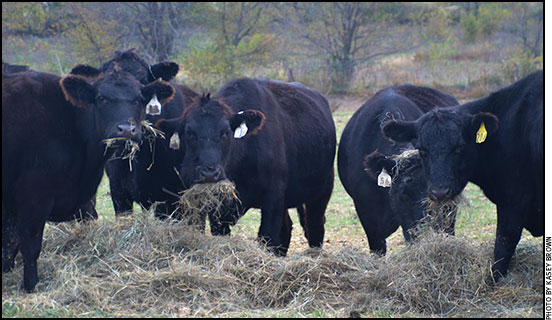HEALTH & NUTRITION...

Winter Nutrition for the Pregnant Cow
The long-term ramifications of being short of protein and energy can carry over for up to two years.
Cows need more and better-quality feed as pregnancy progresses. Nutrient requirements in early gestation are not much different from maintenance requirements, but as the fetus grows larger, the cow’s nutrient needs increase. After calving, when a cow is lactating, she needs a much higher level of protein and energy than when she is pregnant.
Young cows’ requirements are highest because they are still growing. A heifer should be about 85% of her projected mature body weight at breeding, according to Beef and Forage Specialist Barry Yaremcio with Alberta Agriculture and Forestry. During her first pregnancy, the heifer needs to grow a calf and herself at the same time.
For the average beef cow [1,100 to 1,600 pounds (lb.)] the protein requirements in mid-gestation, late gestation and after calving would be a minimum of 7%, 9% and 11%, respectively, on a dry-matter basis. Read more.
Timing Vaccination Against Scours
Five tips offered for preventing scours.
While spring calving seems a long way off, proper vaccine timing could begin this year if your herd calves early in the season.
Prioritize scours prevention to protect the next calf crop. Scours is a potentially fatal infection spread through fecal matter that leaves young calves with no desire to nurse, weak, dehydrated, and with watery and discolored stools. Helping protect calves from scours is more than practicing good animal husbandry — healthy calves, early in life, have been shown to be more productive later in life.
Following best management practices and proper timing, scours vaccination can help prevent scours before calves are born. In their earliest hours of life, calves receive scour-fighting antibodies by consuming colostrum from their dams. Because of this, timing of vaccination related to colostrum production in the cow is critical. Read more.
Warts Are Most Common in Young Cattle
Warts often appear in yearlings and are contagious, often spreading to multiple animals in the group.
Warts are caused by bovine papillomaviruses. Cattle have more problems with papillomaviruses than other domestic animals. J. Dustin Loy, assistant professor of veterinary diagnostic microbiology at the University of Nebraska–Lincoln, says, “Papillomaviruses are species-specific, except that some of the cattle viruses may induce warts or wart-like lesions or sarcoids in horses.”
“There are at least 12 types cattle can get. Some appear in different locations on the animal, and, depending on the type of virus, they may not all look the same,” he says.
They can enter the skin through any injury or scrape. These viruses can also be transmitted by fomites — objects like grooming tools, halters, an ear-tagging tool used on more than one animal, etc., he explains. If you use the tool on a calf that has a papillomavirus and then on a naïve calf, the virus can be passed to the naïve animal. If cattle rub on fences or on each other, the virus can spread readily. Read more.
The 5 Ps To Chuteside Efficiency
Remembering the 5 Ps can greatly enhance your ability to efficiently process cattle.
“If you don’t know BQA, shame on you. Learn it,” Bowie, Texas, veterinarian Arn Anderson told about 250 people gathered to hear his Angus University presentation in early November. “Today we are going to focus on BQA etiquette around the chute that will make you more efficient. … You will live longer, be better at processing cattle, and be a better rancher.”
Anderson was charged with explaining effective Beef Quality Assurance (BQA) protocols chuteside during the educational breakout session Nov. 5 at the 2017 Angus Convention in Fort Worth, Texas. Read more.
Ringworm in Cattle
Often a winter problem, ringworm is most frequently seen in young animals
Ringworm, an unsightly skin disease, is contagious from animal to animal and can be transmitted between species. A person may be at risk for contracting ringworm when handling affected animals. Andi Lear, clinical instructor at the College of Veterinary Medicine at the University of Tennessee, says nearly any type of ringworm can be spread from one species to another. Animals, including humans, can get ringworm if they have a skin abrasion and a compromised immune system.
Ringworm usually appears during winter because the causative fungi thrive in a damp, dark environment. Read more.
OIE Aims to Strengthen U.S. Livestock, Poultry Industries
Texas A&M will host a new office location for the OIE.
The World Organization for Animal Health, also known as OIE, officially opened the U.S.-based liaison office in College Station, Texas, Nov. 6 during a ceremony at the Texas A&M AgriLife Center.
“Our modern agricultural economy is highly dependent upon two things: freedom from disease and trade,” said Melissa Berquist, director of the Institute for Infectious Animal Diseases (IIAD) in College Station. “Following the outbreak of an infectious livestock or poultry disease, the ability to efficiently implement science-based standards and demonstrate freedom from disease is imperative to limiting the loss of revenue, ensuring safe trade and protecting food security.” Read more.
Cattle Diseases: Common Conditions/Terms
Click here for a list of common conditions and terms related to beef cattle diseases, such as anaplasmosis, brucellosis, BVD, E. coli, IBR and others.
[Click here to go to the top of the page.]






